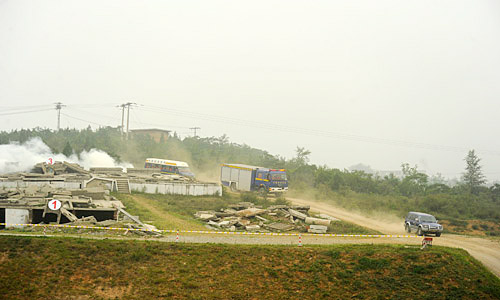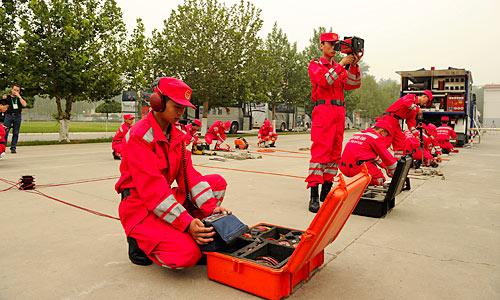|
 |
|
BATTLE BEGINNING: Rescue teams arrive at a simulation earthquake-hit site in time (SHI GANG) |
Since 2009, about 1 million army soldiers and armed police, together with 4.5 million militiamen, have been mobilized for disaster relief work when floods, earthquakes, droughts, typhoons and forest fires occurred, said Geng.
After the 7.1-magnitude earthquake struck Yushu in Qinghai in April, the PLA and PAP dispatched 15,843 troops and 2,773 militia and reserve force members to the disaster site. They brought out 1,564 people and provided initial medical treatment for 80,000 victims.
"Today, we have learned more from the Sichuan and Yushu earthquake rescues and formed a systematic contingency response mechanism, including psychological counseling and situation analysis before a rescue operation," said Liu Xiangyang, Deputy Director of the China International Search and Rescue Team (CISAR).
He said that CISAR members needed to learn more about earthquakes and put up with more complicated disaster situations.
To fight against floods this summer, the PLA and PAP have committed, as of July 29, 383,000 troops and 815,000 militiamen for rescue operations in all the affected areas, Geng said.
They have relocated 1.5 million victims, delivered 50,000 tons of materials, restored 2,544 km of roads, removed 1.28 million cubic meters of debris and reinforced 905 km of dykes.
International operations
In recent years, the Chinese military has diligently performed its international duties, actively participated in UN peacekeeping missions, escorted merchant ships through troubled waters and participated in international humanitarian aid operations, Geng said.
As natural disasters are growing in number and frequency around the world, the Chinese Government and the PLA have established a mechanism to deliver humanitarian relief supplies to other countries.
Since 2002, the Chinese Government and the PLA have delivered 500 million yuan ($73.21 million) of humanitarian relief supplies to 19 countries, Geng said.
 |
|
ADVANCED EQUIPMENT: Soldiers with the Engineering Regiment of Beijing Military Command show their quake-relief equipment on July 30 (SHI GANG) |
Meanwhile, the Chinese military has also set up special teams to help with major relief efforts.
The special rescue team, which is made up of army engineers, armed police medical staff and experts from the China Earthquake Administration, is known as the National Earthquake Disaster Emergency Rescue Team domestically and CISAR internationally, Geng said.
The CISAR, founded in 2001, has already carried out six overseas rescue operations in Algeria, Pakistan, Iran, Indonesia and Haiti.
In 2009, the CISAR passed the evaluation of International Search and Rescue Advisory Group External Classification. The event made China the 12th country in the world to own a heavy urban search and rescue team which qualifies for participating in international deployments.
Huang Jianfa, an official in charge of international relief operations at the China Earthquake Administration, said the 230-member CISAR will be expanded to a 480-strong team by the end of the year.
The Chinese Government will further put in 100 million yuan ($14.6 million) to purchase more advanced equipment for the team, Huang said.
The PLA has actively participated in international exchange and cooperation related to disaster relief work.
Beijing will host with Thailand this autumn an ASEAN Regional Forum seminar on regulations for armed forces participating in disaster relief work.
A forum on non-traditional security will also be held in October in Shijiazhuang in north China's Hebei Province, with ASEAN members, China, Japan and the Republic of Korea all sending delegations.
Geng said that China will send more than 1,000 army and air force officers and soldiers to take part in an anti-terror exercise in Kazakhstan this autumn.
The Peace Mission 2010 exercise will be the seventh of its kind held under the framework of the Shanghai Cooperation Organization (SCO).
It would also be the largest military exercise involving the PLA and troops from other countries this year, he said.
The exercise aimed to demonstrate SCO member states' determination and capacity to combat terrorism, separatism and extremism, showcase their mutual trust and pragmatic cooperation, and the shared wish to protect regional peace and stability.
"As non-traditional security threats become an increasingly severe challenge to the peace and stability of the world, the Chinese military stands ready to work with militaries around the world to jointly enhance our capabilities to fight these threats," Geng said. | 